Note: Because it’s National Pollinator’s Week, this post has been updated and republished.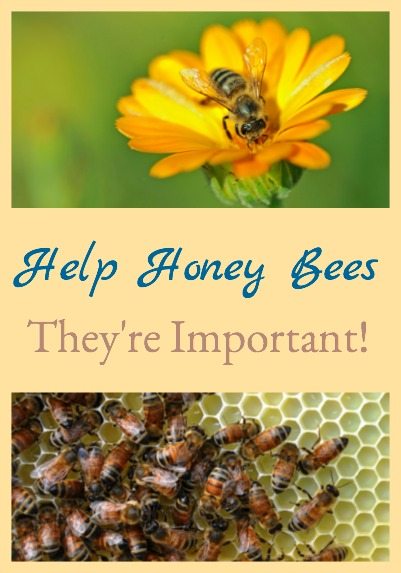
We maintain quite a few honey bee hives, and a common question is why? The obvious answer would be the honey, but it’s actually more complex – honey bees are very important, but their numbers have been declining rapidly in the last several years.
Why They’re Important
Honey bees are important because their pollination is estimated to be responsible for producing one-third of the food we eat worldwide.
According to a recent United Nations study, 70 out of the 100 most important food crops in the world must be pollinated by bees. But the bees are in trouble; since 2006 they have been dying off, in part due to exposure to systemic and other pesticides.
Without enough pollinators, crop yields decline and the varieties of foods that can be produced diminish.
In order to produce food, plants require a few things. For some plants, pollinators are required because they’re incapable of producing fruit without them. Popular plants that require bee pollination include apple, blueberry, cucumber, pumpkin, raspberry, squash, and watermelon (we were amazed at how much our raspberry yield benefitted from having honey bees).
Other plants self-pollinate, but honey bee pollination significantly increases the abundance and size of the plant yield. Plants that benefit from pollination include beans, eggplant, peppers, potatoes, strawberries, and tomatoes.
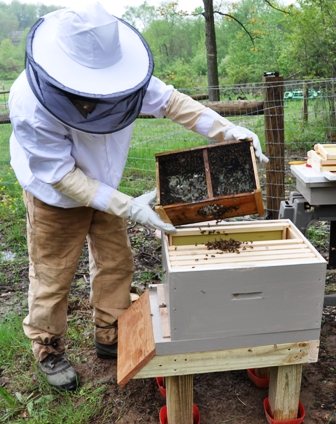
Installing a Package of Honey Bees on Bramblestone Farm
How They Work
Honey bees live in hives organized around a queen, and cannot survive without one. She’s the only female capable of laying viable eggs and lays up to 2000 eggs per day. The other honey bees we generally observe are also females; when they first mature they work as nurse bees, caring for the eggs and feeding the larvae as they hatch. As they grow older, they transition to guard bees, protecting the hive from animals or other insects. Then, they serve as worker bees, flying up to five miles to find food. Male bees are few, and only leave the hive to mate with the queen during her yearly mating flight.
The food (nectar and pollen) collected by the worker bees is fed to hive bees and turned into honey to sustain the hive during the winter when it’s too cold to forage and there’s little food available. While foraging, the worker bees pollinate plants by carrying pollen from one plant to another. This enables the plants to fruit and produce viable seed.
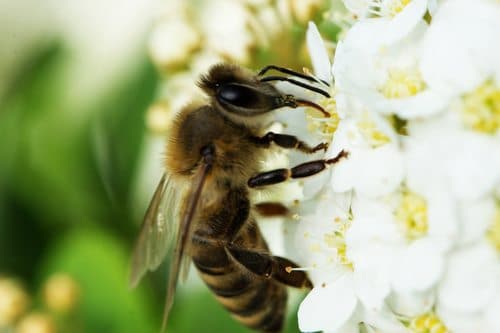
Bee on a flower of the white cherry blossoms.
What’s Happening to Them
The rapid decline in bee numbers has mainly been attributed to two phenomena – colony collapse disorder and neonicotinoid pesticides. Colony collapse disorder was first identified in the winter of 2006 when unprecedented honey bee hive losses (between 30% and 90%) were documented across the United States.
A single cause for colony collapse disorder hasn’t been identified; rather it’s believed to be a combination of factors such as pesticide exposure, pathogens, parasite, and nutritional deficiencies. Whatever the cause, winter hive losses have averaged 30 – 40% in the US since 2006.
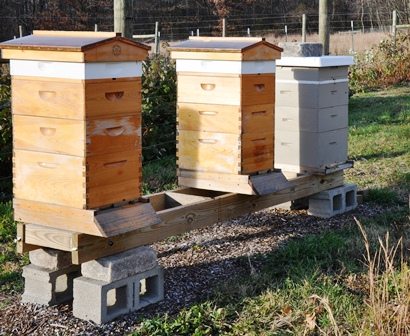
Honey Bee Hives at Bramblestone Farm
Neonicotinoids are systemic pesticides (introduced in the 1990’s) that are neurotoxic to many insects and are especially toxic to honey bees. They are one of the fastest growing classes of pesticides used today and are commonly used to coat seeds and flea collars as well as treat lawns and garden compost. Because systemic pesticides are applied to the plant root (as a seed coating or a pour-on), they are taken in through the plant’s internal system and are given off in the plant’s nectar and pollen.
The use of these pesticides has been connected to numerous instances of major honey bee die-offs, and recent research has shown that even if they don’t immediately kill the bee, they undermine their immune systems making them more susceptible to pathogens and parasites. Four European countries have begun restricting the use of systemic pesticides because of the impact on honey bees.
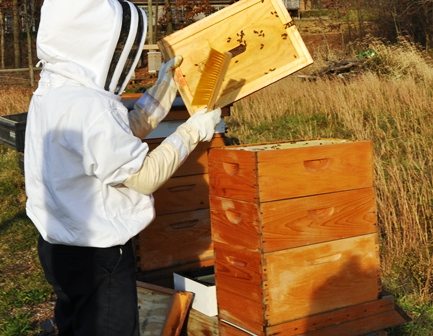
What Can We Do?
Things that can be done to help the honey bees include:
♦ Become knowledgeable about the pesticides that are being used, and make sure you’re not using any of the systemic pesticides that are harming the honey bees
♦ Eat pesticide free foods and support farmers who don’t use pesticides
♦ Plant a garden with plants that bees like – even in cities, a plant container on a balcony can make a difference to urban bees and their keeper
♦ Plant flowers with a mix of colors, shapes and scents to create seasonal buffets
♦ Cut flowers to encourage re-blooming and prolong the foraging window
♦ Grow native plants like echinacea, coreopsis, sunflowers and butterfly weed
♦ Become a beekeeper
SUPPORT BEES IN YOUR GARDEN!
Leave a Reply